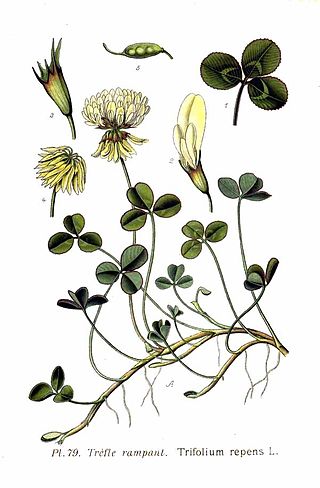
Clover, also called trefoil, are plants of the genus Trifolium, consisting of about 300 species of flowering plants in the legume family Fabaceae originating in Europe. The genus has a cosmopolitan distribution with highest diversity in the temperate Northern Hemisphere, but many species also occur in South America and Africa, including at high altitudes on mountains in the tropics. They are small annual, biennial, or short-lived perennial herbaceous plants, typically growing up to 30 centimetres (12 in) tall. The leaves are trifoliate, with stipules adnate to the leaf-stalk, and heads or dense spikes of small red, purple, white, or yellow flowers; the small, few-seeded pods are enclosed in the calyx. Other closely related genera often called clovers include Melilotus and Medicago.

Quercus pontica, the Pontine oak or Armenian oak, is a species of endangered oak currently extant to the western Caucasus mountains of Georgia and northeastern Turkey where it grows at altitudes of 1,300–2,100 metres.

Trifolium incarnatum, known as crimson clover or Italian clover, is a species of herbaceous flowering plant in the family Fabaceae, native to most of Europe. It has been introduced to other areas, including the United States and Japan.
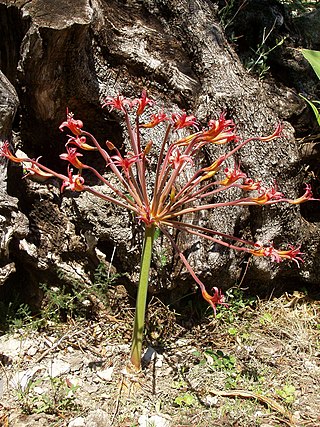
Brunsvigia josephinae, commonly called Josephine's lily or candelabra lily, is a deciduous, subtropical species of Brunsvigia originating from South Africa. It is marked by deep pink to red flowerheads which are about 12 to 15 inches long. It flourishes in medium humidity, at temperatures between 50 and 75 °F. Flowering stems appear from the bulbs in March and April, and the leaves develop later. These bulbs can take 12 years to settle before they flower, but they flower annually once established. It is available from commercial sources.
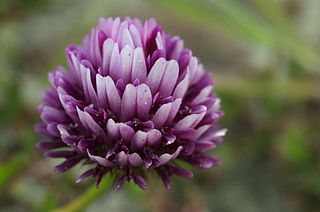
Trifolium wormskioldii is a species of clover native to the western half of North America. Its common names include cows clover, coast clover, sand clover, seaside clover, springbank clover, and Wormskjold's clover.

Trifolium amoenum, known by the common names showy Indian clover and two-fork clover, is endemic to California, and is an endangered annual herb that subsists in grassland areas of the San Francisco Bay Area and the northern California Coast Ranges.
Afzelia pachyloba, the white afzelia or apa, is an economic species of tropical forest tree in the family Fabaceae. It is found in tropical Western and Central Africa where it is threatened by habitat loss.

Trifolium cyathiferum is a species of clover known by the common names cup clover and bowl clover.

Trifolium trichocalyx is a species of clover known by the common name Monterey clover.

Trifolium albopurpureum is a species of clover known by the common name rancheria clover.
Trifolium andersonii is a species of clover known by the common names fiveleaf clover and Anderson's clover. It is native to the western United States, particularly the Great Basin and adjacent high mountain ranges, including the Sierra Nevada. It was named after Charles Lewis Anderson by Asa Gray.
Trifolium beckwithii is a species of clover known by the common name Beckwith's clover.
Trifolium breweri, which has the common names forest clover and Brewer's clover, is a perennial clover that is native to mixed evergreen forests and coastal coniferous forests in Southern Oregon and California.
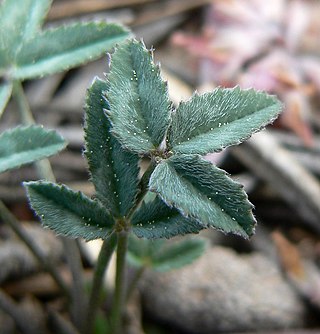
Trifolium gymnocarpon is a species of clover known by the common name hollyleaf clover.

Trifolium macrocephalum is a species of clover known by the common name largehead clover or bighead clover native to the Great Basin region of the western United States.
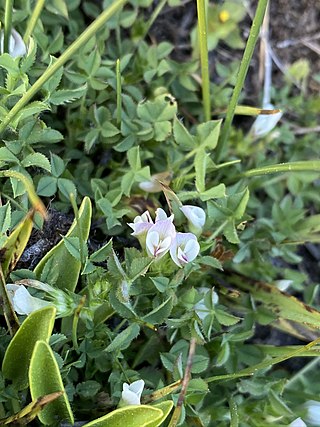
Trifolium monanthum is a species of clover known by the common name mountain carpet clover.
Trifolium jokerstii is a rare species of clover known by the common names Jim's clover and Butte County golden clover. It is endemic to Butte County, California, where it is known from eight or nine occurrences near Oroville. It grows in seasonally moist habitat, such as vernal pools, pastures, and ephemeral creeks. It was previously included within the description of Trifolium barbigerum as an odd yellow-flowered variant of a mostly purple-pink-flowered species, and was elevated to species status in 1998. It was named for the California botanist Jim Jokerst.
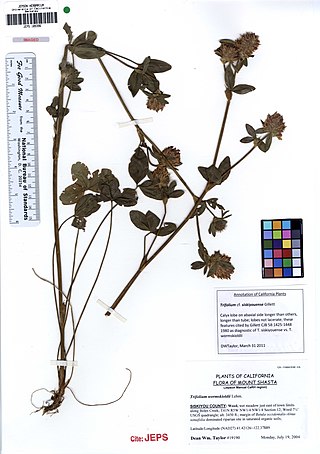
Trifolium siskiyouense, the Siskiyou clover, is a clover species endemic to the Klamath Mountains in the western United States.

Rosa villosa, the apple rose, is a species of rose. It was described in 1753.
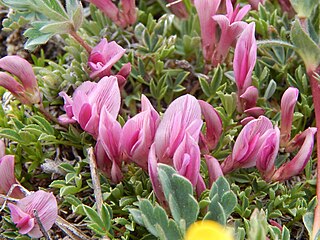
Trifolium nanum, the dwarf clover, is a perennial plant from the family Fabaceae. It was first recorded by Edwin James in 1820. Nanum means, "dwarf," in Latin.















